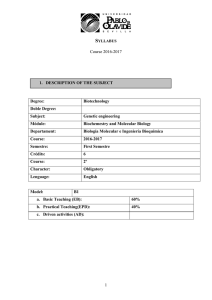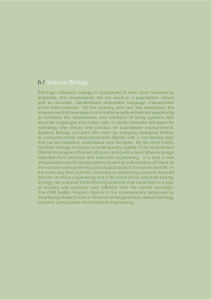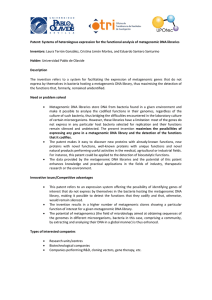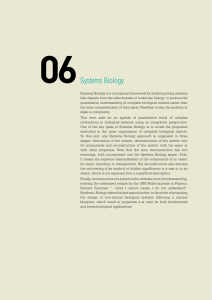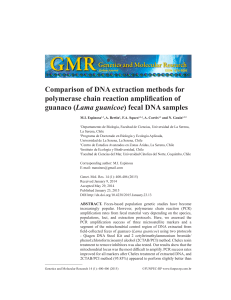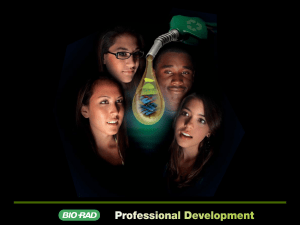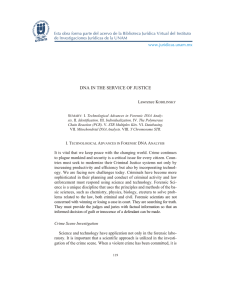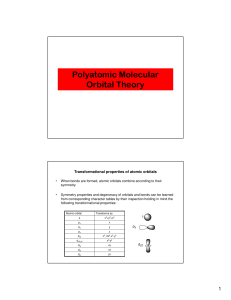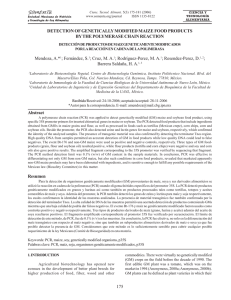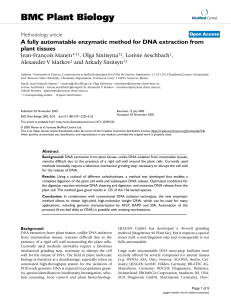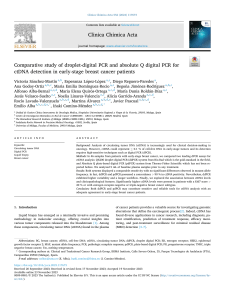Course Guide
Anuncio
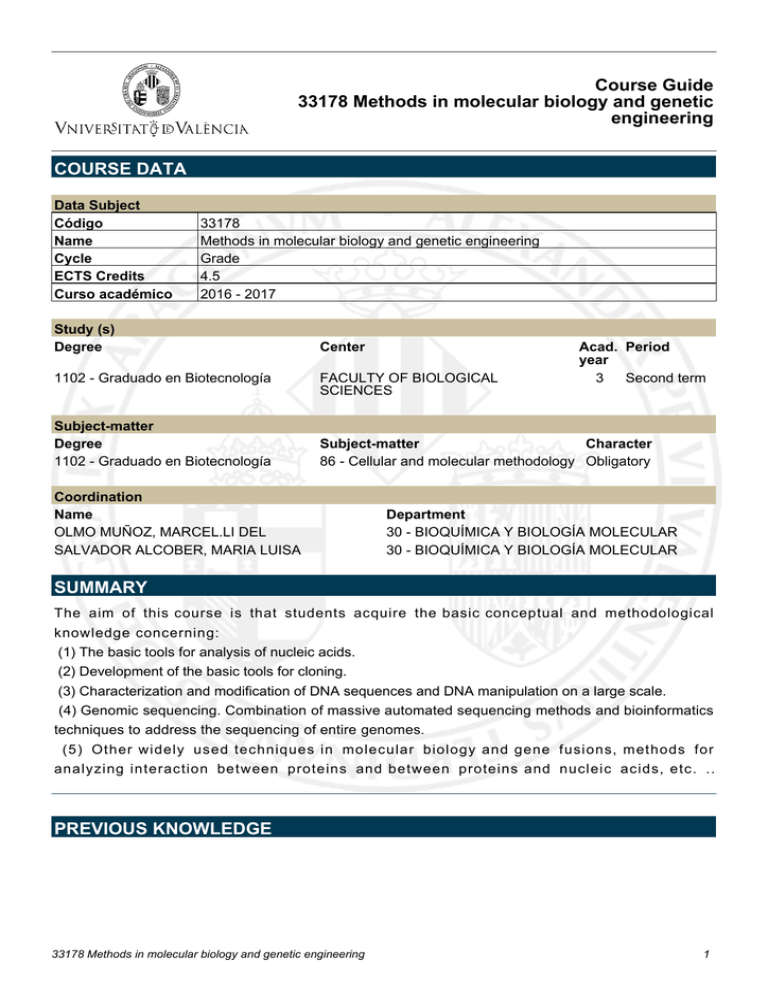
Course Guide 33178 Methods in molecular biology and genetic engineering COURSE DATA Data Subject Código Name Cycle ECTS Credits Curso académico 33178 Methods in molecular biology and genetic engineering Grade 4.5 2016 - 2017 Study (s) Degree 1102 - Graduado en Biotecnología Subject-matter Degree 1102 - Graduado en Biotecnología Center FACULTY OF BIOLOGICAL SCIENCES Acad. Period year 3 Second term Subject-matter Character 86 - Cellular and molecular methodology Obligatory Coordination Name OLMO MUÑOZ, MARCEL.LI DEL SALVADOR ALCOBER, MARIA LUISA Department 30 - BIOQUÍMICA Y BIOLOGÍA MOLECULAR 30 - BIOQUÍMICA Y BIOLOGÍA MOLECULAR SUMMARY The aim of this course is that students acquire the basic conceptual and methodological knowledge concerning: (1) The basic tools for analysis of nucleic acids. (2) Development of the basic tools for cloning. (3) Characterization and modification of DNA sequences and DNA manipulation on a large scale. (4) Genomic sequencing. Combination of massive automated sequencing methods and bioinformatics techniques to address the sequencing of entire genomes. (5) Other widely used techniques in molecular biology and gene fusions, methods for analyzing interaction between proteins and between proteins and nucleic acids, etc. .. PREVIOUS KNOWLEDGE 33178 Methods in molecular biology and genetic engineering 1 Course Guide 33178 Methods in molecular biology and genetic engineering Relationship to other subjects of the same degree There are no specified enrollment restrictions with other subjects of the curriculum. Other requirements Students should have completed in the previous semester (or in previous years) "Molecular Biology" in order to properly understand the contents of this subject. OUTCOMES 1102 - Graduado en Biotecnología - Manejar adecuadamente los equipos y el material propio de un laboratorio de bioquímica y biología molecular. - Saber realizar análisis de expresión génica. - Ser capaz de diseñar protocolos y utilizar las técnicas del DNA recombinante. LEARNING OUTCOMES It is intended that after having completed this course, students could know the basic techniques that are used for gene expression studies and manipulation of genetic material. DESCRIPTION OF CONTENTS 1. Unit 1. What is the technology of the recombinant DNA? Historical introduction. The concept of recombinant DNA. The concept of cloning. The impact of recombinant DNA technology: the emergence of molecular biotechnology. 2. Units 2,3. General Techniques Unit 2. GENERAL TECHNIQUES I. Basic Enzymology used in the manipulation of DNA. Restriction enzymes and restriction maps. DNA polymerases, ligases, recombinases and other enzymes of interest. Precipitation and purification of DNA. Preparation of plasmids and other DNAs. Unit 3. GENERAL TECHNIQUES II. Hybridization of nucleic acids: Factors affecting;steps of the process, methods of hybridization. Probes labelling: direct and indirect types of label, methods of synthesis of a labeled probe. Automated synthesis of oligonucleotides. Applications of synthetic oligonucleotides. Complete gene synthesis. 3. Unit 4. Methods for the analysis of gene expression Detection and quantification of the transcript. Use of reporter genes. Identification of regulatory elements of transcription. Mapping messengers. Methods for the analysis of individual gene expression. Analysis of differentially expressed genes. Transcription in vitro and in vivo. Translation in vitro. 33178 Methods in molecular biology and genetic engineering 2 Course Guide 33178 Methods in molecular biology and genetic engineering 4. Unit 5. Polymerase chain reaction (PCR) Characteristics of PCR: amplification and specificity. Basic reaction: design of primers. Analysis of the PCR product: cloning and direct sequencing. PCR reverse. .Amplification of cDNA: RT-PCR. The PCR as a tool in genetic engineering. Quantitative PCR. PCR applications in other fields. Other amplification systems. 5. Units 6-9. Genetic Engineering Unit 6. CONSTRUCTION OF CHIMERA DNA. Cloning strategies. Binding of DNA molecules: binding of sticky ends, binding by adding linkers, adapters, and homopolymer tails. Introduction of DNA into bacterial cells: transformation and transfection methods. Unit 7. Cloning vector in E. coli. General characteristics of a vector. Plasmids. Cloning vectors based on plasmids. Phages. Cloning vectors based on phage M13: single stranded vector. Phagemids. Cloning vectors based on phage . Cosmids and vectors for large inserts. Expression vectors in E. coli: bacterial promoters. Unit 8. Library construction. Genomic libraries. Libraries for sequencing projects. cDNA synthesis methods. Clones with 3 ' ends or 5' of mRNAs. cDNA libraries. Subtracted cDNA libraries. Unit 9. SELECTION OF CLONES. Levels of selection. Identification of recombinant clones. Identification of a specific clone. Direct selection. Selection by immunological techniques. Selection by hybridization with nucleic acid probes. 6. Unit 10: DNA sequencing Sequencing methods. Automatic sequencing. Strategies for seque ncing a DNA fragment. 7. Unit 11. Modification of the DNA sequence Mutagenesis in vitro of passenger DNA: deletions, insertions and substitutions. Random mutagenesis. Directed mutagenesis using oligonucleotides. Directed mutagenesis techniques based on PCR. Random insertional mutagenesis. 8. Techniques for studying protein-DNA interactions: gel mobility shift;Unit 12. Unit 12. Study of macromolecule interactions Techniques for studying protein-DNA interactions: gel mobility shift; Protection to the attack of nucleases and chemical agents in vitro and in vivo; Methylation interference; Cross-linking with UV light. Chromatin immunoprecipitation. Purification of proteins that bind to DNA. Techniques for studying RNA-protein interactions: gel retardation assay; chemical modification protection assay; Methods of affinity; Crosslinking by UV light; Triple hybrid. Techniques for studying protein-protein interactions: Purification of protein complexes, two hybrid, co-immunoprecipitation, Pull-down of tagged proteins; Application of fluorescent proteins for detecting protein interactions in vivo. 9. Laboratory classes 1) Construction of a gene library in Escherichia coli 2) Purification of a GST fusion protein 3) Construction of the restriction map of a plasmid 4) Obtaining gene-specific probes by PCR 33178 Methods in molecular biology and genetic engineering 3 Course Guide 33178 Methods in molecular biology and genetic engineering WORKLOAD ACTIVITY Theory classes Laboratory practices Preparation of evaluation activities Preparing lectures TOTAL Hours 29.00 16.00 30.00 20.00 95.00 % To be attended 100 100 0 0 TEACHING METHODOLOGY The development of the course is structured around theoretical sessions, personal tutorials and practical sessions. 1. Theoretical sessions: The section on classroom work includes a total of 26 sessions of one hour corresponding to lectures, seminars or tutorials. Before each class, students will have all the artwork that will be meaningful presented in the website for the Virtual Classroom of the University of Valencia. Thus, it is intended that the student can prepare in advance the classes in order to follow them easier, taking only the notes needed for proper understanding. 2. Personal Tutoring: The role of tutoring is to help and guide personally the student in all the problems that arise in dealing with the study of the subject. They facilitate the exchange of views between teacher and student, in an effort to approach to individualized instruction. 3. Practical activities: 4-5 sessions are scheduled with 2-4 hours each (total 16 h). In these sessions several aspects of the techniques of molecular biology and recombinant DNA and other related subjects which are not considered in theoretical sessions and are adaptable to laboratory practice are included. EVALUATION At the end of the course will be a test to evaluate together the knowledge acquired in the lectures and practices. On the final note this exam will represent 85%. The remaining 15% corresponds to the value of work in practical classes. Attendance at laboratory is mandatory and so is the submission of a report at the end of them. To pass the course is necessary to pass the theory exam and the work done in practical classes. In the exam students should get at least 25% of the maximum score in each one of its two parts. If practice component is approved but the theory is not, then the practice note will be held for the following year; from that moment students have to repeat the lab classes. 33178 Methods in molecular biology and genetic engineering 4 Course Guide 33178 Methods in molecular biology and genetic engineering REFERENCES Basic - PRIMROSE S.B. y TWYMAN R.M. (2006). "Principles of gene manipulation and Genomics." 7ª ed. Blackwell Publishing. - GREEN, M.R.y SAMBROOK, J. (2012). Molecular Cloning. A laboratory manual. 4ª ed. Cold Spring Harbor Laboratory Press (3 volúmenes). - IZQUIERDO, M. (1999). Ingeniería genética y transferencia génica. Ed. Pirámide - JAIN, M. (2012) Recombinant DNA techniques. Alpha Science International Ltd. Oxford, U.K. Additional - AUSUBEL, F.M. et al. (1987-). Current protocols in Molecular Biology. John Wiley & sons. - BROWN, T.A. (2011). Gene cloning and DNA analysis. An introduction. 4ª ediction. Ed Blackwell Science - GLICK, B.R. y PASTERNAK, J.J. (2010). Molecular Biotechnology. Principles and applications of recombinant DNA. 4ª Ed. ASM Press. - GLOVER D. M. y HAMES B.D. (1995). DNA cloning (vol 1, 2, 3, 4). A practical approach. IRL Perss - KREUZER, H. y MASSEY, A. (1996). Recombinant DNA and Biotechnology. A guide for teachers. ASM Press. - LUQUE, J. y HERRAEZ, A. (2001) Biología Molecular e Ingeniería Genética. Harcourt. - PERERA, J., TORMO, A. y GARCIA J.L. (2002). Ingeniería genética. Vol.I. y Vol II. Ed. Síntesis. - WATSON, J.D.; GILMAN, M.; WITKOWSKI, J. y ZOLLER, M. (1992). "Recombinant DNA". 2a ed. Scientific American Books. - WINNACKER E.L. (ed.) (1987). "From genes to clones". VCH. - AUSUBEL, F.M. et al. (1987-97). Current protocols in Molecular Biology. John Wiley & sons. - BIRREN ET AL. (1999). Genome analysis. 4 Volúmenes. Cold Spring Harb. Lab.Press - DIEFFENBACH, C.W. y DVEKSLER, G.S. (1995). PCR primer. A laboratory manual. Cold Spring Harbor. 33178 Methods in molecular biology and genetic engineering 5
